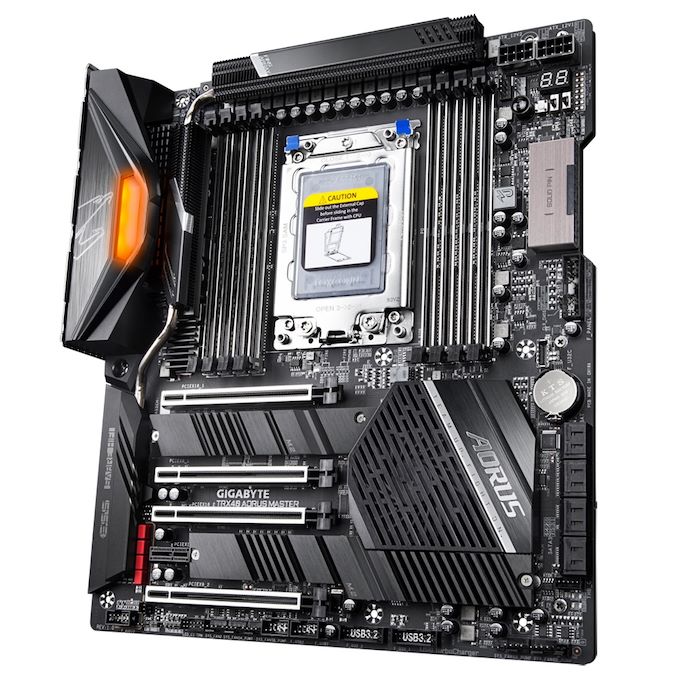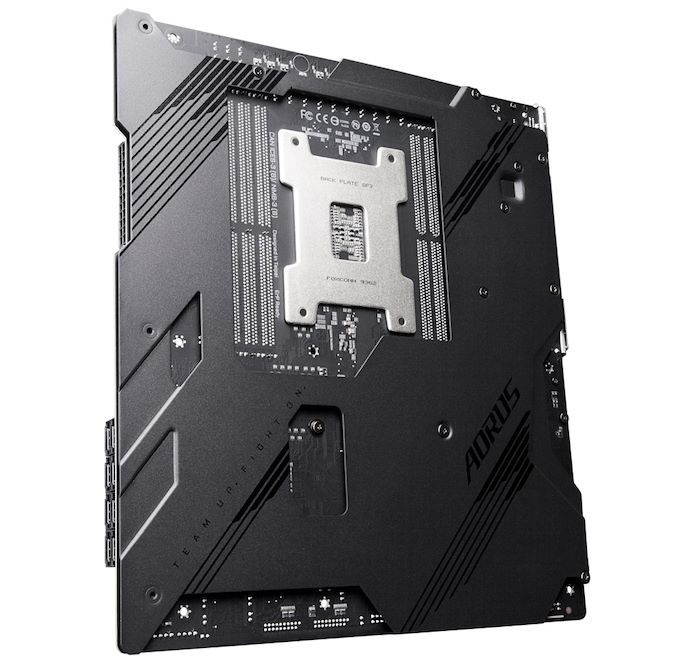The AMD TRX40 Motherboard Overview: 12 New Motherboards Analyzed
by Gavin Bonshor on November 28, 2019 9:00 AM EST- Posted in
- Motherboards
- AMD
- MSI
- Gigabyte
- ASRock
- Asus
- TRX40
- Threadripper 3000
- Castle Peak
GIGABYTE TRX40 Aorus Master
The GIGABYTE TRX40 Aorus Master sits below the TRX40 Aorus Xtreme in the product stack and combines a similar style, in a slightly smaller, but still larger than normal E-ATX PCB. Still retaining the high-end feel, the TRX40 Master is using an E-ATX PCB which is crammed with good quality controllers. The most notable features include support for DDR4-4400 and 256 GB, a pair of Ethernet ports on the rear panel including an Aquantia 5 G controller, Intel's AX200 Wi-Fi 6 wireless interface, and a beefy 16-phase CPU power delivery.
Starting from the top, the GIGABYTE TRX40 Aorus Master has eight memory slots in two banks of four on either side of the sTRX4 socket with support for DDR4-4400 and up to 256 GB in total. Taking a slightly more basic approach to the aesthetics, the rear panel cover does include integrated RGB LEDs, with black heatsinks on a black PCB. The large black aluminium power delivery heatsinks which are interconnected via a heat pipe are cooling a 16-phase power which consists of an Infineon XDPE132G5C 16-phase PWM controller, with sixteen Infineon TDA21472 70 A power stages. Providing power to the CPU is two 8-pin 12 V ATX power connectors which are located in the top right-hand corner.
Also at the top right-hand corner of the board is a two-digit LED debug, while below this is a right-angled 24-pin motherboard power connector. For PCIe devices, there are four full-length PCIe 4.0 slots which operate at x16/x8/x16+x8 and a single PCIe 4.0 x1 slot. The TRX40 chipset heatsink is actively cooled just as we saw with X570. For storage, the GIGABYTE TRX40 Aorus Master has three PCIe 4.0 x4 M.2 slots which include M.2 heatsinks for each slot, and there are eight SATA ports with support for RAID 0, 1, and 10 arrays.
Like with the GIGABYTE TRX40 Aorus Xtreme, the TRX40 Aorus Master also includes a large black metal backplate which will add extra weight to the board. The backplate displays the motto 'Team Up, Fight On' which is more of a gaming term, which is understandable given the boards Aorus branding. The TRX40 Aorus Master includes dual BIOS with a switch which allows users to select between the two, and for cooling, there is a total of eight 4-pin headers. These are split into one for a CPU fan, one dedicated for a water pump, and six for chassis fans.
On the rear panel are five USB 3.1 G2 Type-A, one USB 3.1 G2 Type-C, and two USB 2.0 ports. There are two Ethernet ports with one controlled by an Aquantia 5 G, and the other by an Intel Gigabit Ethernet controller. This model also includes Intel's AX200 Wi-Fi 6 wireless interface and also adds BT 5.0 connectivity too. To the left-hand side is a Clear CMOS and Q-Flash Plus switch, with the five 3.5 mm audio jacks and S/PDIF optical output handled by a Realtek ALC4050H and Realtek ALC1220 audio codec pairing. The TRX40 Aorus Master also includes a Realtek ALC4050H and ESS Sabre 9218 DAC for the front panel audio.
The GIGABYTE TRX40 Aorus Master is still a high-end TRX40 motherboard and with an MSRP of $499, it isn't exactly cheap, but it does offer users plenty of good quality features on AMD's new HEDT platform. While the Aorus brand is mainly targeted at gamers, the TRX40 Aorus Master looks to combine elements from both the enthusiast and gaming sides, to create a reasonably priced multi-purpose model for all looking to use and unlock all of the power within the Threadripper 3000 processors.













109 Comments
View All Comments
dan82 - Thursday, November 28, 2019 - link
I wish those boards had more Type C ports and dropped some of those A ports. A type C port can easily be turned in an A, but vice versa is against the spec.Also serious question: what is the reason to keep A 2.0 ports around? Are there any devices that don’t work on modern ports?
jeremyshaw - Thursday, November 28, 2019 - link
Probably much easier to route one old and slow data pair vs 1-4 high speed data pairs.I have many devices that will likely never need more than USB 2.0 - my Mouse and KB included. USB microphone as well. The best external device I've got that benefits from USB3 speeds is my Bluray burner, and we all know how popular those are. External USB flash drives are usually limited by the cheap NAND inside, and most of my external storage is on my network.
For others, I suppose USB capture cards? Really decent USB 3.0 flash drives? Even if I connected my phone to my PC, it's still limited to USB 2.0. Maybe a decent external card reader? These boards reviewed here are all ATX, so I'll rule out USB NICs. I've got to be missing something in my list.
eek2121 - Friday, November 29, 2019 - link
There is still the odd device that doesn't work on USB 3.0. Also the last 2 machines I've built did not have fully functioning USB 3.0/3.1 ports in Linux, indicating lack of driver support for operating systems other than Linux. In short: USB 3.x is still a WIP despite being out on the market for quite a while.Llawehtdliub - Saturday, November 30, 2019 - link
Plz no. Dont do an Apple. Just beczus you cant think of a reason to use doesnt mean others cant.There is a reason to leave them.
dotes12 - Saturday, November 30, 2019 - link
Bring back PS/2 ports too? /sasmian - Thursday, November 28, 2019 - link
I'm a little confused by comments on the X570 boards that will probably apply to these also. With these new PCIe4 slots (and M.2 slots), is it the case that they are all completely independent and you can mix/match PCIe2/PCIe3/PCIe4 cards/drives freely at each one's maximum possible negotiated link speed? Or will putting (say) a PCIe2 RAID controller in any slot reduce all slots to the lowest common denominator, PCIe2 speed?voicequal - Thursday, November 28, 2019 - link
PCIe lanes are wired directly to the PCIe controller on either the CPU or chipset, so link speeds between slots are independent. PCIe 4.0 is backward compatible with previous generations 3.0, 2.0 & 1.0, so running a PCIe 2.0 card in a slot capable of 4.0 will run at 2.0 speeds and not affect adjacent lanes on other slots.Some motherboards allow you to reduce the maximum speed of PCIe lanes from 4.0 to something lower -- this can help to troubleshoot signal integrity issues. This setting sometimes does affect lanes across multiple slots. But as long as you leave it to Auto, the lanes will run at the highest compatible speed between card and controller.
WaltC - Friday, November 29, 2019 - link
Yes, in most cases the slots auto-configure to the device connected. Gen 3 devices should happily coexist with Gen 4 devices with each running at spec. In the case of the GPU, you can run it at Gen 3 if you prefer even if it is a Gen 4 GPU natively--there's separate switch for that in the bios, but the slots auto-configure for other devices and the GPU bios switch doesn't affect any other slots.I was surprised to see that several of the mboards had no rear clear-CMOS button on their backplates, and thought that was an interesting omission from the article--and the article also failed to mention dual-bios mboards--which the GB Aorus Xtreme & Master have (pictured mechanical switches) --one would hope they all might have them. Seems as if both these important features would be worth a mention...
dotes12 - Saturday, November 30, 2019 - link
Is there any downsides of going to PCIe 4.0? Maybe something similar to DDR3 and DDR4 memory where the bandwidth increases, but the latency goes up too?PopinFRESH007 - Sunday, December 29, 2019 - link
not really no